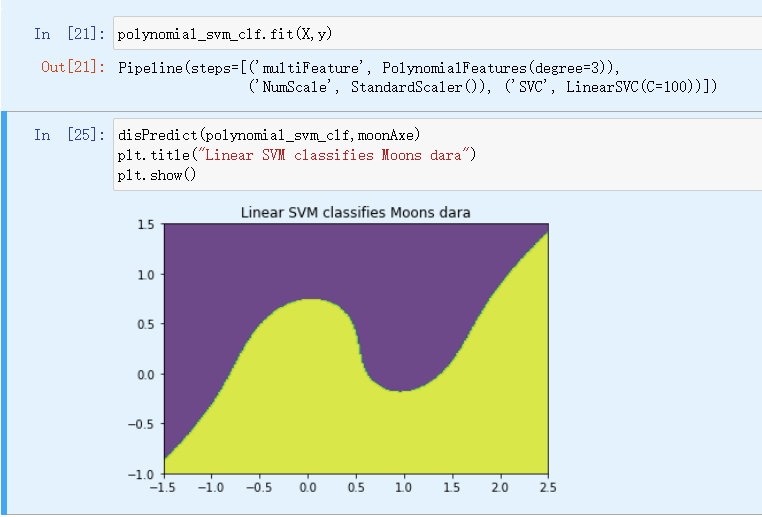(一)实验名称:SVM(支持向量机)算法实验
(二)实验目的:
- 学习支持向量机SVM的基本概念
- 了解核函数的基本概念
- 掌握使用scikit-learn API函数实现SVM算法
(三)实验内容:使用scikit-learn API中的SVM算法解决非线性分类的问题
(四)实验原理
(五)实验步骤
- 建立工程
- 数据准备、分析
- 模型训练
- 模型可视化
- 模型预测
相关代码如下

import numpy as np
import matplotlib.pyplot as plt
from sklearn.datasets import make_moons
from sklearn.preprocessing import PolynomialFeatures
from sklearn.preprocessing import StandardScaler
from sklearn.svm import LinearSVC
from sklearn.pipeline import Pipeline
import warnings
warnings.filterwarnings('ignore')
X,y=make_moons(n_samples=100,noise=0.1,random_state=1)
moonAxe=[-1.5,2.5,-1,1.5]
def dispData(x,y,moonAxe):
pos_x0=[x[i,0] for i in range(len(y)) if y[i]==1]
pos_x1=[x[i,1] for i in range(len(y)) if y[i]==1]
neg_x0=[x[i,0] for i in range(len(y)) if y[i]==0]
neg_x1=[x[i,1] for i in range(len(y)) if y[i]==0]
plt.plot(pos_x0,pos_x1,"bo")
plt.plot(neg_x0,neg_x1,"r^")
plt.axis(moonAxe)
plt.xlabel("x")
plt.ylabel("y")
def disPredict(clf,moonAxe):
d0=np.linspace(moonAxe[0],moonAxe[1],200)
d1=np.linspace(moonAxe[2],moonAxe[3],200)
x0,x1=np.meshgrid(d0,d1)
X=np.c_[x0.ravel(),x1.ravel()]
y_pred=clf.predict(X).reshape(x0.shape)
plt.contourf(x0,x1,y_pred,alpha=0.8)
dispData(X,y,moonAxe)
polynomial_svm_clf=Pipeline(
(("multiFeature",PolynomialFeatures(degree=3)),
("NumScale",StandardScaler()),
("SVC",LinearSVC(C=100))
)
)
polynomial_svm_clf.fit(X,y)
disPredict(polynomial_svm_clf,moonAxe)
plt.title("Linear SVM classifies Moons dara")
plt.show()相关结果的截图


写注释的代码
import numpy as np
import matplotlib.pyplot as plt
from sklearn.datasets import make_moons
from sklearn.preprocessing import PolynomialFeatures
from sklearn.preprocessing import StandardScaler
from sklearn.svm import LinearSVC
from sklearn.pipeline import Pipeline
import warnings
warnings.filterwarnings('ignore') # 忽略警告
# 生成半环形数据
X,y=make_moons(n_samples=100,noise=0.1,random_state=1)
moonAxe=[-1.5,2.5,-1,1.5] # moons数据集区间
# 显示数据样本
def dispData(x,y,moonAxe):
pos_x0=[x[i,0] for i in range(len(y)) if y[i]==1]
pos_x1=[x[i,1] for i in range(len(y)) if y[i]==1]
neg_x0=[x[i,0] for i in range(len(y)) if y[i]==0]
neg_x1=[x[i,1] for i in range(len(y)) if y[i]==0]
plt.plot(pos_x0,pos_x1,"bo")
plt.plot(neg_x0,neg_x1,"r^")
plt.axis(moonAxe)
plt.xlabel("x")
plt.ylabel("y")
# 显示决策线
def disPredict(clf,moonAxe):
# 生成区间内的数据
d0=np.linspace(moonAxe[0],moonAxe[1],200)
d1=np.linspace(moonAxe[2],moonAxe[3],200)
x0,x1=np.meshgrid(d0,d1)
X=np.c_[x0.ravel(),x1.ravel()]
# 进行预测并绘制预测结果
y_pred=clf.predict(X).reshape(x0.shape)
plt.contourf(x0,x1,y_pred,alpha=0.8)
# 1.显示样本
dispData(X,y,moonAxe)
# 2.构建模型组合,整个三个函数
polynomial_svm_clf=Pipeline(
(("multiFeature",PolynomialFeatures(degree=3)),
("NumScale",StandardScaler()),
("SVC",LinearSVC(C=100))
)
)
# 3.使用模块组合进行训练
polynomial_svm_clf.fit(X,y)
# 4.显示分类线
disPredict(polynomial_svm_clf,moonAxe)
# 5.设置图标标题
plt.title("Linear SVM classifies Moons dara")
plt.show()





















 5095
5095











 被折叠的 条评论
为什么被折叠?
被折叠的 条评论
为什么被折叠?










